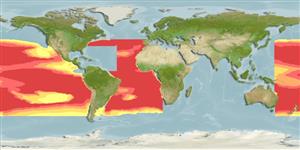>
Argentiniformes (Marine smelts) >
Opisthoproctidae (Barreleyes or spookfishes)
Etymology: Monacoa: The name constructed by Whitley was without any etymological reason; however, it is likely referring to the state of Monaco, in which the research expedition that sampled the two syntypes originated..
Environment: milieu / climate zone / depth range / distribution range
Écologie
marin bathypélagique; profondeur 0 - 4750 m (Ref. 58018), usually 300 - 400 m (Ref. 6542). Deep-water; 43°N - 49°S, 149°E - 15°E
Tropical to subtropical Atlantic and Pacific oceans.
Taille / Poids / Âge
Maturity: Lm ? range ? - ? cm
Max length : 8.0 cm SL mâle / non sexé; (Ref. 6542)
Épines dorsales (Total): 0; Rayons mous dorsaux (Total): 14-17; Épines anales 0; Rayons mous anaux: 8 - 9. Dorsal part of head transparent, ventral part and ventral 2/3 of body peppered with large melanophores; ventral surface of rear part of sole with 4 dark blotches (Ref. 6597). Body deep and anal fin on a vertical at posterior end of the sole, short based, rays directed posteriorly (Ref. 37473).
Mesopelagic (Ref. 58302). The limits of its distribution are marked by the 10°C isotherm and the 34, 8 %o isohaline (Ref. 6542).
Life cycle and mating behavior
Maturité | Reproduction | Frai | Œufs | Fécondité | Larves
Quéro, J.-C., 1990. Opisthroproctidae. p. 241-243. In J.C. Quero, J.C. Hureau, C. Karrer, A. Post and L. Saldanha (eds.) Check-list of the fishes of the eastern tropical Atlantic (CLOFETA). JNICT, Lisbon; SEI, Paris; and UNESCO, Paris. Vol. 1. (Ref. 6542)
Statut dans la liste rouge de l'IUCN (Ref. 130435)
Menace pour l'homme
Harmless
Utilisations par l'homme
Pêcheries: sans intérêt
Plus d'informations
Noms communsSynonymesMétabolismePrédateursÉcotoxicologieReproductionMaturitéFraiRassemblement de ponteFéconditéŒufsDéveloppement de l'œuf
RéférencesAquacultureProfil d'aquacultureSouchesGénétiqueElectrophoresesHéritabilitéPathologiesTraitementNutrientsMass conversion
Outils
Articles particuliers
Télécharger en XML
Sources Internet
Estimates based on models
Preferred temperature (Ref.
123201): 8.8 - 17.3, mean 12.4 °C (based on 59 cells).
Phylogenetic diversity index (Ref.
82804): PD
50 = 0.6250 [Uniqueness, from 0.5 = low to 2.0 = high].
Bayesian length-weight: a=0.02188 (0.00844 - 0.05670), b=2.98 (2.75 - 3.21), in cm total length, based on LWR estimates for this (Sub)family-body shape (Ref.
93245).
Niveau trophique (Ref.
69278): 4.0 ±0.28 se; based on food items.
Résilience (Ref.
120179): Haut, temps minimum de doublement de population inférieur à 15 mois (Preliminary K or Fecundity.).
Fishing Vulnerability (Ref.
59153): Low vulnerability (10 of 100).
